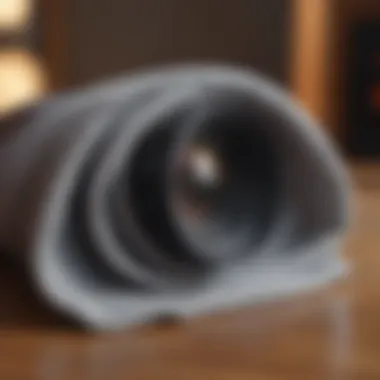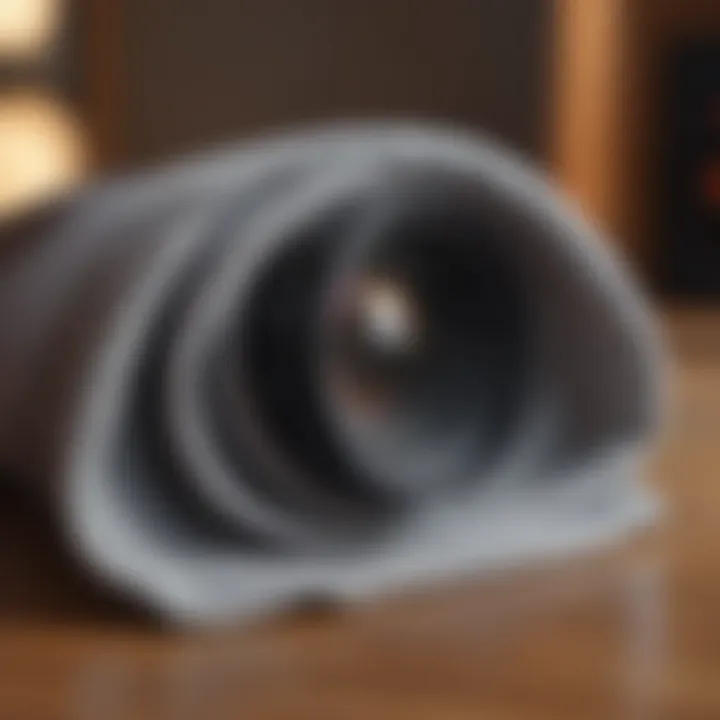Choosing the Best Cloth to Clean Your TV Screen Safely


Intro
Cleaning a TV screen seems simple, yet doing it wrong can cause irreversible damage. Many viewers remain unaware that choosing the right cloth is crucial. The right material can effectively remove dust, fingerprints, and smudges without risking scratches or harm to the screen's finish. This article will unpack various cloth options, discussing their effectiveness and suitability concerning different screen types. It aims to shed light on best practices for cleaning while preserving display quality.
Understanding Screen Types
Before selecting a cloth, one must recognize the type of screen being cleaned. Modern televisions generally fall into three main categories: LCD, LED, and OLED. Each comes with its own unique surface characteristics that can be affected by improper cleaning. Knowing this assists in selecting an appropriate cleaning cloth and technique.
- LCD Screens: These screens often have a protective layer. However, they can still scratch easily, so soft materials are essential.
- LED Screens: Like LCDs, LED screens also require gentle cloths. Their glossiness may show marks more clearly.
- OLED Screens: OLED screens offer superior picture quality but can be more sensitive to harsh cleaners or abrasive materials.
Choosing the proper cleaning cloth can significantly enhance the longevity of your screen.
Selecting the Right Cloth
When it comes to cleaning cloths, there are several fabric options that stand out:
- Microfiber Cloths: These are typically made from a blend of polyester and polyamide. They are soft, non-abrasive, and exceedingly effective in trapping dust. Recommended for all screen types.
- Cotton Cloths: While cotton is soft, it can leave lint behind and may not be as effective as microfiber in getting rid of smudges.
- Silk Cloths: Though luxurious and gentle, silk can trap particles that might scratch the screen.
- Paper Towels: They are not recommended for delicate screens. They can scratch surfaces and leave fibers behind.
"Using an incorrect cloth can lead to permanent damage. Always choose what is safest for your screen."
Best Practices for Cleaning
Once the right cloth is selected, proper cleaning techniques become vital. Here are the steps to ensure effective cleaning:
- Power off the TV: Turn off the television and allow it to cool. This makes dirt and smudges more visible.
- Gently Dust with Dry Cloth: Start with a dry microfiber cloth to eliminate loose dust. Avoid pressing too hard.
- Moisten the Cloth: If necessary, lightly dampen the cloth with distilled water or a specialized screen cleaner. Avoid excess moisture.
- Wipe in Circular Motion: Use circular motions, applying minimal pressure to avoid streaks.
- Dry the Screen: Follow up with a dry area of the cloth to remove any remaining moisture.
Maintaining Displays
Regular cleaning and proper cloth selection help maintain the display's quality. Here are additional tips for ongoing care:
- Avoid harsh chemicals and sprays, as they can damage the screen.
- Store cleaning cloths in a clean, dry place to avoid picking up dust and debris.
- Clean the screen gently and regularly to prevent buildup.
Foreword to TV Screen Care
In today's digital age, the television serves not only as a source of entertainment but also as an integral part of many home environments. Understanding how to properly care for your TV screen is essential. This topic underlines the importance of regular maintenance and the right cleaning techniques. Doing so extends the lifespan of the device while preserving the picture quality that one enjoys.
Regular cleaning prevents dust, grime, and fingerprints from accumulating on the screen. Left unchecked, these elements can lead to a deterioration of the display over time, potentially resulting in an unsatisfactory viewing experience. Moreover, using unsuitable cleaning materials can cause scratches or streaks, which might be irreversible. Thus, selecting the right cloth is not merely a matter of aesthetics, but an obligation to ensure the longevity of this important appliance.
In summary, understanding the protocols for cleaning and maintaining your TV screen has practical benefits. It promotes better visual performance while protecting the device from damage. With the profound impact of screen upkeep on display quality, it is essential for every TV owner to educate themselves on optimal cleaning practices.
The Importance of Screen Maintenance
The maintenance of LCD, LED, or OLED screens is critical for several reasons. For one, these screens are sensitive to improper care. By regularly performing maintenance, one can prevent visible distortions often caused by dirt buildup. Also, screens that are not cared for properly may experience shorter lifespans, necessitating earlier replacements. Regular cleaning enhances the overall viewing experience, allowing one to appreciate the clarity and vibrancy that modern TVs are designed to deliver.
Proper maintenance also contributes to the overall aesthetic of the living space. A clean screen complements the modern decor and contributes positively to the ambiance of a room. In this regard, clean screens represent a commitment to quality and attention to detail in a household's environment.
Common Cleaning Misconceptions
Many people hold misconceptions regarding the cleaning of TV screens. One prevalent myth is that any cloth can be used for cleaning. This belief can lead to using materials that may cause scratches or worse, permanent screen damage. Many assume that paper towels are a viable cleaning tool, but these often contain rough fibers that can scratch delicate surfaces.
Additionally, some believe that all cleaning solutions are safe for screens. However, certain chemicals, particularly those found in general household cleaners, can strip away protective coatings on modern screens. Thus, it is vital to use recommended solutions or cloths designed specifically for the screen material.
Types of TV Screens


Understanding the different types of TV screens is crucial when selecting the optimal cloth for cleaning. Each screen type has unique properties and requires specific care to avoid damage while maintaining clarity. The three principal categories of TV screens—LCD, LED, and OLED—each present their own considerations. Selecting the right cleaning method helps to preserve the integrity of the screens and enhances viewing experiences.
Screens
LCD (Liquid Crystal Display) screens are known for their clarity and efficiency. They utilize liquid crystals sandwiched between layers of glass or plastic. When it comes to cleaning LCD screens, using the correct cloth is vital. Microfiber cloths are highly recommended. They are gentle and effective at removing dust and fingerprints without scratching the surface.
However, it is important to avoid abrasive materials, such as paper towels or rough fabrics, as these can cause surface scratches. Instead, utilize a soft microfiber cloth slightly dampened with water or a suitable screen cleaning solution. This helps to avoid streaks and maintains the optical quality of the display.
LED Screens
LED (Light Emitting Diode) screens are essentially a type of LCD screen enhanced with LED backlighting. This technology allows for brighter images and enhanced color. Just like LCD screens, LED screens require careful handling during cleaning. Using a microfiber cloth remains the best approach.
To maintain the quality of an LED screen, a dry microfiber cloth can usually suffice for dust removal. For smudges, a slightly damp cloth should be used, ensuring no excess liquid drips onto the electronic components. Uncoated paper towels may seem appealing for their absorbency, but they often leave fibers or scratches.
OLED Screens
OLED (Organic Light Emitting Diode) screens offer superior picture quality and deeper blacks compared to both LCD and LED screens. However, they can be particularly sensitive to cleaning techniques. Given their delicate nature, one should exercise greater caution when cleaning OLED screens.
A high-quality microfiber cloth is still the best choice. It is essential to gently wipe the screen without applying too much pressure. Many experts suggest using a dry cloth, as moisture can sometimes lead to issues with the screen's coating. If necessary, one can use a slightly damp microfiber cloth but should ensure to use it sparingly.
In summary, recognizing the type of screen is critical in choosing the appropriate cleaning cloth. Each screen type has its nuances, and understanding these can greatly enhance the longevity and appearance of your television.
Recommended Cloth Materials for Cleaning
Choosing the right cloth material for cleaning your TV screen is vital for maintaining its condition. A suitable material can prevent scratches, reduce static, and effectively remove dust and grime. Different materials have specific characteristics that make them more or less suitable for various types of screens. This section discusses three primary cloth materials: microfiber, cotton, and synthetic cloths. Each material has unique benefits and considerations that can impact cleaning effectiveness and screen safety.
Microfiber Cloths
Benefits of Microfiber
Microfiber cloths are commonly regarded as one of the best options for cleaning delicate surfaces. One significant advantage is their ability to pick up tiny particles, including dust and oils, without needing chemical cleaners, which can be harmful to screens. Their density allows for effective cleaning without abrasive action, reducing risks of scratches.
Moreover, microfiber cloths are highly absorbent, making them very efficient for removing fingerprints or smudges. They are often lightweight and easy to wash, contributing to their eco-friendliness. Again, their reusability means they provide a longer-term cleaning solution compared to disposable wipes.
How to Use Microfiber Safely
Using microfiber cloths safely involves a few straightforward techniques. First, make sure the cloth is clean and dry before use, as dirt particles trapped in the cloth can scratch the screen. When wiping the screen, it is crucial to apply light pressure; excessive force might still damage the screen or push debris into the surface.
It is also beneficial to move the cloth in straight lines rather than circular motions. This method reduces the risk of streaks and allows for more thorough cleaning. Lastly, avoid mixing microfiber cloths with fabric softeners during washing, as this can cause them to lose their cleaning effectiveness over time.
Cotton Cloths
Pros and Cons
Cotton cloths are a popular choice for household cleaning. They are gentle and typically less expensive than microfiber. Cotton is absorbent, which is a positive feature for larger spills. However, cotton does not have the same fabric structure as microfiber, which limits its ability to capture fine particles.
The major downside is that cotton can sometimes leave behind fibers on screens. This can be frustrating when cleaning a display. It is crucial to note that while cotton cloths are readily available, they may not always provide the same level of protection against scratches as microfiber options.
Appropriate Usage
Cotton cloths can be useful when cleaning screens that are not sensitive to mild friction. They are best employed for dusting or wiping down the TV frame rather than the screen itself. When using cotton for cleaning, ensure no loose threads or lint are left on the surface.
To optimize the use of cotton cloths, slightly dampen them before cleaning. This method dims down any fabric shedding and enhances clean capability. Using them on tougher stains or for light touch-ups on the screen can be effective, but one should remain cautious of potential fibers left behind.
Synthetic Cloths


Evaluating Performance
Synthetic cloths offer a different cleaning experience. They are designed to be durable and often feature specialized surfaces for different cleaning tasks. While they can effectively remove dirt and grime, they may not be as gentle as microfiber or cotton.
Careful evaluation is required to determine the appropriate synthetic cloth for TV screen cleaning. Some synthetic materials can potentially scratch or harm sensitive screens due to their coarse texture. However, they excel in environments where heavy-duty cleaning is necessary, such as kitchen or workshop spaces.
Best Application Scenarios
Synthetic cloths can be best applied in contexts that require more robust cleaning. For instance, they might be suitable for wiping the surrounding areas of the TV or for cleaning hard surfaces. On the other hand, softer synthetic options are available, designed specifically for electronics, which can offer a balanced approach to cleaning the screen itself.
In this case, understanding the correct type of synthetic cloth is vital. Choosing a product labeled as safe for screens can prevent possible damage and ensure that it performs adequately in cleaning duties.
Choosing the right cleaning cloth can make a significant difference in screen maintenance and longevity. Consider the specific needs of your TV model and cleaning habits.
Comparative Analysis of Cleaning Cloths
When considering the best cloth for cleaning TV screens, a comparative analysis of cleaning cloths is crucial. This section examines different cloths based on their effectiveness in removing dirt, potential scratching risks, and overall longevity. Understanding these facets enables readers to make informed choices about which cloth to use, aligning with the goal of preserving the screen's integrity and enhancing viewing quality.
Effectiveness in Dirt Removal
The primary function of any cleaning cloth is its ability to remove dirt. Microfiber cloths stand out in this category. Their unique structure traps dirt and dust particles like a magnet, allowing for effective cleaning without the need for additional products. Microfiber's high absorbency is particularly beneficial for oily smudges, which is a common occurrence on screens. For those who opt for cotton cloths, they can serve adequately for regular dusting, although they might struggle with stubborn grime. Synthetic cloths, depending on the specific composition, can also vary in effectiveness; selecting the right type is essential for optimal results.
Potential for Scratching
Another critical factor when selecting a cleaning cloth is the potential for scratching the screen. Screens are vulnerable to damage, especially soft coatings on LED and OLED models. Microfiber is generally safe, thanks to its soft fibers and non-abrasive nature. In contrast, some cotton and synthetic blends may have rough edges or fibers which could lead to scratches if not used properly. It is vital to inspect cloths before use—ensuring that no dirt or hard particles are trapped that might compromise the surface integrity.
"Choosing the right cleaning cloth significantly impacts not only the clarity of the screen but also its longevity."
Longevity and Reusability
In considering the longevity and reusability of cleaning cloths, microfiber cloths again take the lead. They are generally machine washable and can withstand multiple cleaning cycles without losing effectiveness. Cotton cloths, while durable, may fray over time, especially if subjected to frequent washings. Synthetic cloths vary in their durability, and some may not offer the same reusability benefits as microfiber. Assessing the lifecycle of a cleaning cloth can make a substantial difference in both cost and environmental impact, as more durable options reduce the need for replacement.
Proper Cleaning Techniques
Choosing the right cleaning techniques is crucial for maintaining the integrity of your TV screen. Proper techniques not only ensure effective cleaning but also minimize the risk of scratching or damaging the screen surface. Several factors contribute to cleaning success. These include understanding the type of screen you have, the kind of dirt or smudges present, and the subtleties of different cleaning materials.
When cleaning, a strategic approach is beneficial. It helps in effectively managing dust, smudges, and fingerprints without using excessive force. Excessive force can lead to screen damage, and the wrong cleaning methods can degrade screen quality over time. Therefore, a mindful practice is essential.
Dust Removal Techniques
Dust accumulation on a TV screen is inevitable. However, removing it should be done with care. To effectively manage dust:
- Use a microfiber cloth: These cloths are designed to trap dust rather than push it around.
- Gentle motion is key: Wipe in a gentle, circular motion to lift away dust rather than drag it across the screen.
- Avoid cloths with fabric softeners: These types can leave a residue that compromises image clarity.
- Regular maintenance: Regularly dusting helps maintain a cleaner screen and reduces the amount of effort needed during deeper cleans.
Handling Smudges and Fingerprints
Smudges and fingerprints can be a nuisance. Effective strategies for dealing with them include:
- Dampening a microfiber cloth: Slightly wet a microfiber cloth with distilled water or a solution specifically designed for screens.
- Apply the solution directly to the cloth: Avoid applying liquid directly onto the screen as it may seep into the edges and damage internal components.
- Light pressure: Use gentle pressure and wipe in a systematic manner. This ensures thorough cleaning without risk of scratches.
- Drying: After cleaning, allow the screen to dry naturally or use a dry section of the microfiber cloth for a final pass. This clears any remaining moisture away.
Utilizing these methods enhances screen care. Overall, focusing on proper techniques guarantees a long-lasting viewing experience, preserving screen clarity and functionality.
Mistakes to Avoid While Cleaning


Cleaning a TV screen is not as straightforward as it may seem. Understanding the mistakes to avoid is critical. A single misstep can lead to irreversible damage, impacting performance and visual quality. Addressing these mistakes not only preserves the device but also enhances the viewing experience.
Using Improper Materials
One of the most common mistakes people make is selecting inappropriate materials for cleaning their screens. Using paper towels, rough fabrics, or any abrasive materials can lead to scratches. These scratches may not be immediately visible, but they accumulate over time, degrading the screen's clarity.
It is essential to choose soft, non-abrasive cloths. Microfiber cloths are generally the best option because they are designed to trap dust and debris without causing harm. Unlike paper towels, they do not contain harsh fibers that can scratch surfaces. Always check that any cleaning material is compatible with your screen type to avoid costly repairs.
Over-Application of Cleaning Solutions
Another prevalent issue is the over-application of cleaning solutions. Many people assume more cleaner equals cleaner screens, but this could not be further from the truth. Excess liquid can seep into the edges of the screen, leading to internal damage. The key is to dampen the cloth, not saturate it.
When using a cleaning solution, it is critical to choose a product specifically designed for screens. Generic cleaners might contain harsh chemicals that can strip away protective coatings. Furthermore, applying cleaner directly onto the screen is risky. Instead, spray it on the cloth. This method helps ensure control over the amount of solution used and prevents unintentional damage to the display.
"Less is often more when it comes to achieving a streak-free, safe clean."
In summary, avoiding improper materials and over-application of cleaning solutions are vital. These considerations help in maintaining the screen's longevity and performance. Before cleaning, take a moment to reflect on these mistakes, and ensure you are equipped with the right tools and techniques.
Sustainable Cleaning Practices
Sustainable cleaning practices are increasingly vital in today’s environmentally conscious world. Choosing the right cloth for cleaning your TV screen is not just about effective cleaning—it's also about making responsible material choices that have lesser impacts on the planet. By focusing on sustainable options, one can contribute to reducing environmental footprints while simultaneously caring for valuable technology.
In the context of cleaning your television screen, sustainable practices encompass various aspects, including the materials used for cloths and the methods adopted during the cleaning process. Sustainable materials are often biodegradable or manufactured through processes that minimize resource consumption. While shopping for cleaning supplies, consider options that align with these principles.
Eco-Friendly Cloth Options
When it comes to eco-friendly cloths for cleaning TV screens, several materials stand out.
- Bamboo Fiber Cloths: These cloths are made from a sustainable resource and are known for their absorbent properties. Bamboo is naturally antibacterial, making these cloths not only effective but also hygienic.
- Organic Cotton Cloths: Using organic cotton means the cultivation process avoids harmful pesticides. Organic cotton cloths are absorbent and soft, reducing the likelihood of scratches on screens.
- Recycled Polyester Cloths: Blending recycled plastics into cleaning cloths supports waste reduction initiatives. Such cloths offer durability and effective dirt removal properties, making them ideal for screen maintenance.
These options reduce the reliance on synthetic materials that contribute to pollution. Opting for eco-friendly cloths ensures that you clean your screen responsibly while promoting sustainability.
Reducing Waste in Cleaning Materials
Reducing waste is a crucial element of sustainable cleaning practices. By adopting strategies that minimize material consumption and extend the life of cleaning tools, one can significantly lessen ecological impact. Here are some practical tips:
- Choose Reusable Cloths: Unlike disposable wipes or paper towels, reusable cloths reduce landfill waste. After cleaning, they can be washed and reused multiple times, adding convenience and sustainability.
- Implement Smart Cleaning Frequency: Avoid over-cleaning your screen. Regularly dusting and promptly addressing smudges can lessen the need for frequent deep cleaning, which can wear down cloths more rapidly.
- Use Appropriate Cleaning Solutions: Selecting the correct solutions minimizes excess waste. Use only small amounts of designated cleaners to avoid both product waste and the need for frequent replacements.
"Incorporating sustainable cleaning practices into daily routines not only helps maintain the longevity of screens but also supports larger environmental goals."
By focusing on these principles, you create a dual impact: maintaining the quality of your TV instead of contributing to further waste. Making small adjustments can lead to significant contributions toward sustainability.
Closure
In any discussion of maintaining a television's longevity and performance, the conclusion serves as a vital anchor point. This section emphasizes the critical decisions surrounding the cloths you use for cleaning. Selecting the proper cleaning material can minimize damage and enhance the clarity of your screen. It's not merely about removing dust; rather, it's about safeguarding your investment against unnecessary wear.
Utilizing the right cloth contributes to the overall viewing experience by preserving the screen's functionality. An optimal cleaning cloth can also affect the display quality. If your chosen material is too abrasive, it may leave scratches or smudges, negatively impacting your enjoyment. This speaks to the fine balance required when caring for your screen. Proper care results in reduced glare and improved image clarity.
Summary of Key Points
- Importance of Material: Choosing the right cloth is essential for effective cleaning without inflicting damage.
- Effectiveness: Different fabrics have distinct cleaning capabilities, influencing how dirt and grime are removed.
- Screen Type Compatibility: Some cloths are better suited to specific screen types, whether it be LED, LCD, or OLED, impacting their performance.
- Sustainability Factor: Opting for eco-friendly cloths not only helps the environment but can also enhance the cleaning process.
- Best Cleaning Practices: Understanding techniques, such as dust removal and handling smudges, ensures that the chosen cloth meets your cleaning needs effectively.
"Investing time to understand the nuances of cleaning materials for your TV can significantly enhance your overall viewing satisfaction."
Final Recommendations
To sustain the quality of your television for years to come, follow these recommendations:
- Use Microfiber Cloths: Microfiber is remarkably effective at trapping dust and less likely to scratch screens.
- Avoid Rough Materials: Stay clear of paper towels or anything coarse, as they can leave scratches.
- Be Cautious with Cleaning Solutions: Apply cleaning fluids sparingly and never directly onto the screen; this minimizes the risk of damage.
- Regular Maintenance: Clean your screen regularly to reduce build-up and make the process easier over time.
- Educate Yourself: Stay updated on safe cleaning practices to ensure you are always informed about the best methods.
In summary, understanding the significance of the cloth you choose for cleaning a TV screen enhances not only its appearance but also functional durability. Employing the right materials and techniques leads to a more satisfying viewing experience.







